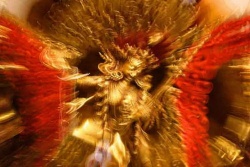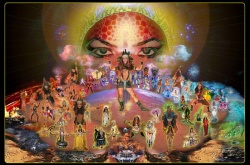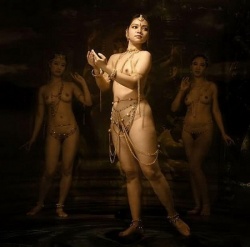Ratna Dakinis
“Ratna Dakini” by Phyllis Glanville
“The Ratna Dakinis’ themes are banishing, victory, kindness and Karma. Their symbols are the color yellow. In Tibet, these Goddesses rule over all gestures of goodness and compassion, which naturally help improve Karma. Collectively, their name means ‘inestimable,’ showing us the true power and value in acts of kindness that are driven by a pure heart.
The The Hemis Festival includes a ritual playing which all manner of mythic creatures are poised against the Tibetan lamas, symbolizing the battle between good and evil. Bells, censers, cymbals and drums draw in positive magic, banish evil and win the fight for Ratna Dakinis’ goodness. In keeping with this idea, string together some yellow-colored brass bells for a Ratna Dakinis house amulet. Hold these in your hand and empower them by saying,
‘Let you goodness ring, let purity sing, with each wind Ratna Dakinis’ blessing bring!’
Hang these where they will catch the wind regularly, releasing the magic.
Wear something yellow today to keep Ratna Dakinis in mind so that your actions will be gentle and filled with kindness. Do something nice for someon who’s been feeling blue lately, ‘just because.’ Give them some yellow flowers, offer a hug, or maybe make an extra bell amulet for them too! This boosts good Karma, makes both of you feel good and invoks Ratna Dakinis’ blessings through thoughtfulness.”
“The term Dakini is Sanskrit. It’s Tibetan equivalent is Khadro, kha meaning ‘sky’ and dro meaning to ‘go’. Taking it together, Khadro means one who can move through the sky. It’s very important we think about this literal meaning in trying to understand Dakinis. Now, all dakinis are portrayed in female form — there male counterpart being called dakas. There are enlightened dakinis and unenlightened dakinis.
The unenlightened dakinis are termed worldly dakinis because they are still caught in the cyclic world of samsara. Worldly dakinis are found in human form as well as in astral (lunar) form and could have a form of a beautiful fairy-like being or a demonic flesh-eating being. An example of a worldly dakini are the Five evil Tseringma sisters Padma Sambhava tamed (control) into protectors. Another example of a worldly dakini is a celestial messenger falling into the category of a protector bodhisattva performing beneficial actions. Another example might be a great human practitioner that has accomplished some insight but who is not yet released from suffering.
The enlightened dakinis are the Wisdom Dakinis. They have passed beyond samsara into liberation and an example of an enlightened dakini would be any one of the female yidam or one of the female consorts to the Five Dhyana Buddhas.
There are five families of Worldly and Wisdom Dakinis: Vajra Dakinis, Ratna Dakinis, Padma Dakinis, Karma Dakinis, and Buddha Dakinis. And both the worldly dakinis and wisdom dakinis can have supernatural powers. You may recall the story of Tilopa where he encountered a number of various dakinis. The worldly dakinis who had control over sight and sound bombarded him with mirages after which he met the dakinis embodying the five activities and finally he met with the wisdom dakini in the heart of the mandala.
The dakinis are born in three manners:
1) Spontaneously enlightened ones arise from Sambogakaya‘s unfoldment from Dharmakaya. Example of these Dakinis being Tara and Vajrayogini.
2)Those born in heavenly realms. Those who are born from within the heavenly realms and those who reach the heavenly realms though their own attainment.
3)Finally, those born by realization of mantra. These are humans who have reached various levels of inner realization.
So, as you can see, there are many different types and levels of dakinis. Dakinis in general can be a guiding light along the path removing physical and spiritual hindrances. They can play a great part in an individual’s attainment of enlightenment. They are the forces that awaken dormant qualities of spiritual impulses hidden in the subconscious. It is the dakini’s inspirational influence that can open one and remove obstacles. But, it is the Wisdom Dakinis that we should be interested in learning about and who we can rely on to truly release us from samsara.” [1]
“The Ratna (Precious) Dakinis represent South, grandness and compassion.”
[2] The family is Ratna Family, or the jeweled family, have the following associations:
The color is golden yellow.
The element is earth.
The symbol is the jewel.
The afflicted pattern is arrogance, pride; which covered feeling of inadequacy, not being good enough, creating greed, consuming hunger, consuming of all kinds.
The wisdom is of fundamental reality, the reality of equality, which is the same energy when the struggle is released. Release of all self-advancements, self-importance and over barring attitudes to a relaxed state of equanimity and generosity, like the earth.
The Ratna Dakini has full body, has good sense of humour, and likes bright colours. Her knife is ornamented with the jewell. In Her left hand She holds the scull cup, with nectar of knowledge brimming out of it. In the crook of her left arm is the Katvanga staff – the inner consort. She is golden. Wisdom flames of equanimity and unchanging stillness emanate from Her body.
The seed syllable is – “RI”


